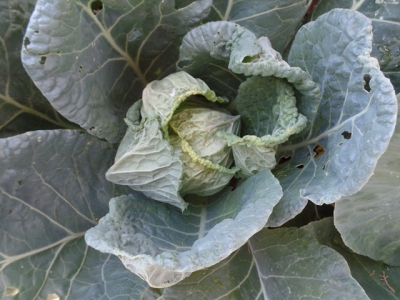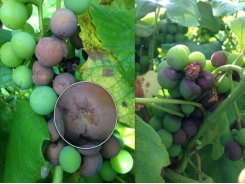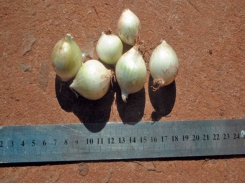Practicing IPM with cabbages

It requires a lot of observation and experience, but Integrated Pest Management (IPM) can be practiced with cabbages.
I learnt this purely by accident. At the time, my brassica crop only amounted to a few thousand plants intended for evaluation purposes. My son kept guinea pigs and rabbits as pets and would feed them the cabbage leaves. On one occasion, after I’d finished with my trial, I told him to use the cabbages as soon as possible because diamond back moth (DBM) larvae were building up and I didn’t want to see an outbreak that would spread to the next planting.
I also didn’t want to spray the infected area, because I intended to use it as feed. I got distracted by other work. After a couple of weeks, I returned to the land expecting all the plants to be covered with caterpillars.
White cocoons
To my surprise there were only a few. Instead, dozens of small wasps were closely scanning the leaves. I also found plenty of smaller, white cocoons in place of the larger, green cocoons produced by the DBM larvae. Some of the white cocoons were still being spun alongside shrivelled-up DBM larvae from which the wasp larvae had emerged.
The following trial also had a number of wasps scouring the leaves looking for moth larvae. This was the last time for years that I needed to spray for caterpillars. I just had to spray for aphids in autumn, as discussed in last week’s article.
This situation ended with a very cold winter which had a severe impact on the wasp population, and I had to spray in early summer.
I used Bio Cure, which has little impact on the wasps, but is effective against the caterpillars. It’s one of a number of such products. But as all have to be consumed by the caterpillars, spraying needs to be more thorough than with most toxic products.
Danger period
Usually, the danger period is early summer. Warm and dry conditions favour the rapid development of DBM larvae, which may be thinned out by naturally occurring micro-organisms in moist conditions. The wasp population is also usually at its lowest at this time. In addition, those who use water with a high mineral content will have deposits on the leaf surface due to dry, windy conditions. These render most insecticides less effective, making moth control almost impossible in extreme cases.
I have a client who annually ‘seeds’ his cabbages with wasps purchased from the ARC, and then uses the aforementioned products to keep the DBM population down until the parasitoids (wasps) increase and sustain control for the rest of the season. DBM isn’t the only caterpillar threat. Bollworm larvae can also be a problem. These come in suddenly and can do a lot of damage.
Other wasps
The best approach is to have pheromone traps around the land, so you’ll know when the moths are around and can plan to spray a safe product a few days later when the eggs have hatched. Look carefully and you’ll find these eggs laid singly near the edge of young leaves. They’ll need to be sprayed soon after hatching, and before the caterpillars go deeper into the plant and out of reach of insecticides.
A very effective parasitoid controls the semi-looper which is why it’s not a major cabbage pest. In small areas there are a couple of species of large wasps which scout the leaves for caterpillars. These are those long wasps which make hanging nests under the eaves of houses. There’s a shorter species which makes similar nests, but usually in pipes or protected places. Both chew up caterpillars as feed for their young.
They can be very effective and take care of all my bollworm. I often find them scouting my bean crops for caterpillars as well.
As they attack humans who venture too near to their nests, they’re usually killed, but they should always be protected.
Related news
Tools

Phối trộn thức ăn chăn nuôi

Pha dung dịch thủy canh

Định mức cho tôm ăn

Phối trộn phân bón NPK

Xác định tỷ lệ tôm sống

Chuyển đổi đơn vị phân bón

Xác định công suất sục khí

Chuyển đổi đơn vị tôm

Tính diện tích nhà kính

Tính thể tích ao




 A guide to growing baby carrots
A guide to growing baby carrots  Drought and disease development in maize
Drought and disease development in maize